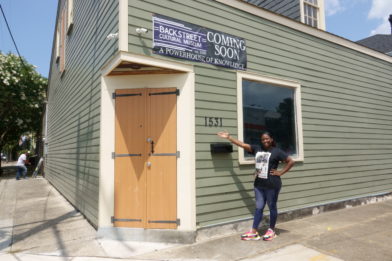Standing in front of the door at the corner of St. Philip Street and North Robertson one might imagine all of the people, especially neighborhood folks, who had a ball there during the building’s many incarnations as a barroom and music club. According to official city records, the address where the Backstreet Cultural Museum will now call home is 1531 St. Philip Street, but back in the day, the same destination was listed as 1533 St. Philip Street. Trumpeter and vocalist Kermit Ruffins even used the address as the title of his 2001 album on Basin Street Records. At the time, Ruffins had recently opened his club, Kermit Ruffins’ Jazz & Blues Hall, at the very spot. “It’s the exact heart of the Treme,” Ruffins declared in the liner notes.
A banner announcing “Backstreet Cultural Museum, A Powerhouse of Knowledge, Coming Soon” now hangs on the St. Philip Street side of the now-renovated, mint-colored building. It’s just over six blocks from the original museum, founded by the late Sylvester Francis in 1999, in another historic building, the Blandin Funeral Home on Henriette Delille Street. Rented by the museum, it had long been in disrepair and received a final blow when a huge branch of a pecan tree fell on the building during Hurricane Ida.
A U-Haul truck sits near the museum’s new locale, having delivered some of the first items to be exhibited, such as Mardi Gras Indian suits and memorabilia from social aid and pleasure clubs and jazz funerals. These include some items that have been in temperature-controlled storage since the demise of the Backstreet’s original location. Francis’ daughter, Dominique, who became the executive director of the museum upon her father’s death on September 1, 2020, is there at the corner with members of her team making sure things are going as planned. Dominique has signed a one-year lease with the owner that offers an option for renewal.
The barroom area that the museum will occupy is 975 square feet of open space that probably seems larger than it did when a roomful of customers sidled up to the bar and musicians provided entertainment to happy dancers. The new track lighting installed on the room’s high ceilings certainly meets the needs of the museum that’s largely visual while the original tile floors retain the building’s history.
“The biggest challenge is going to be placement and being able to keep all of the new items and receive new ones,” says Dominique. “My answer to fix that challenge is that I’m going to be doing a three-to-six-month rotation.”
“The one thing that will always be there [in the museum] is the photograph of my great-great- grandmother from 1949,” she adds, speaking of the wonderful, black-and-white photo of a masked Anita Thomas, the Big Queen of the 8th Ward Hunters. Many, but not all of the beautiful, intricately-beaded and feathered suits donated by Big Chief Victor Harris of the Spirit of Fi Yi Yi Mardi Gras Indian gang will also definitely be included. Another must is the mural depicting Dominique’s father that was part of a “house float” during the pandemic-stricken 2021 Carnival season.
The Backstreet’s new location is just kitty-corner from Tuba Fats Square, a gathering place for many of the activities of New Orleans’ Black street culture—second lines, Black masking Indians. It sits right next to the Candlelight Lounge, that’s also a historic site and remains one of the few live music venues in Treme. Those of a certain age might remember that the Candlelight once hosted Black Indian practices of the White Cloud Hunters led by Big Chief Little Charles Taylor. Just down North Robertson Street is Fatma’s Cozy Corner, which once housed the notably popular bars Ruth’s Cozy Corner and Joe’s Cozy Corner.
“I do hope to go around and meet all the neighbors personally,” Dominique says, pointing out that she and the owner of the Candle Light, LeCole Alexander, the daughter of the late Leona “Chine” Grandison, represent a new generation taking over family businesses.

Executive Director Dominique D. Francis at the Backstreet Cultural Museum’s new location. Photo by Keith Hill
The whole of Treme, which was until more recently known as the 6th Ward, brimmed with barrooms, juke joints and music clubs. Benny Jones, the drummer and leader of the Treme Brass Band remembers that in the 1950s and ’60s Joe Washington’s Bar occupied 1533 St. Philip Street, named for the proprietor. It was a place people from the neighborhood would go regularly just to hang out.
According to Jones, next up on that corner was another barroom, the Tap Room, owned by Leo Gilyat. Then Melvin “Greasy” Davis, who, incidentally, is the father of Dirty Dozen trumpeter Gregory “Blodie” Davis, took over and named it Melvin’s Bar where there would be music now and then, primarily for private parties. “I played there, and it was a stop for second lines and jazz funerals,” Jones remembers. “They would all stop or break up there. Indians used to come around there too.”
Next, the building took on an historic name by becoming the Caldonia with some calling it the Caldonia Two. The well-loved original Caldonia was located in the part of the Treme neighborhood that was razed in 1971 to create Armstrong Park. During its second incarnation in the 1980s and ’90s when live music filled the room, Benny Jones lived in a small house, long since demolished, behind the club and next to its patio on North Robertson Street.
After the club changed hands, when the now world-renowned musician Troy “Trombone Shorty” Andrews was just a little kid, he had the nightspot named after him by his mother, Lois Andrews. Naturally, by this time live music prevailed at Trombone Shorty’s.
The doors of 1533 St. Philip Street closed following its rather short life as Kermit’s Jazz & Blues Hall. As things often happen in the Treme’s close-knit community, Sylvester Francis acted as Kermit’s doorman there. That the doors that Francis once stood by should now open to the Backstreet Cultural Museum run by his daughter seems to fulfill a certain aspect of the circle of life.
Starting Tuesday, July 12, 2022, the Backstreet Cultural Museum will be open for visitors to tour. Regular business hours will be Tuesday through Saturday from 10 a.m. to 4 p.m. The museum is located at 1531 St. Philip Street.




